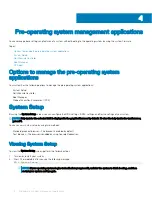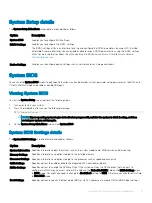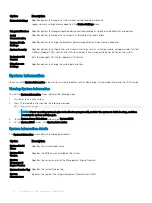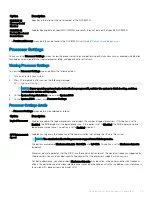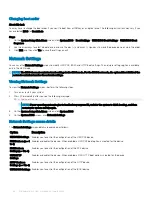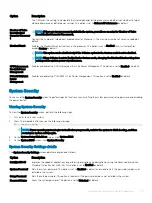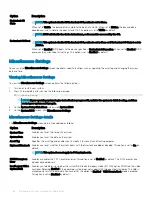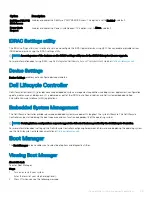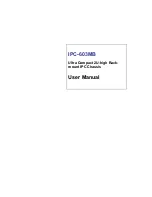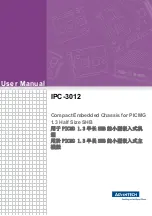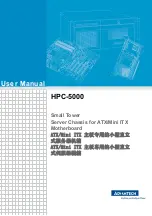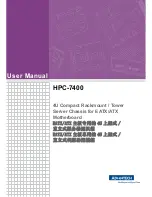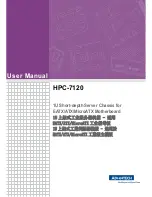
Option
Description
However, if power saving considerations outweigh performance, you might want to reduce the frequency of the
CPU communication links. If you do this, you should localize memory and I/O accesses to the nearest NUMA node
to minimize the impact to system performance.
Virtualization
Technology
Enables or disables the virtualization technology for the processor. This option is set to
Enabled
by default.
Adjacent Cache
Line Prefetch
Optimizes the system for applications that need high utilization of sequential memory access. This option is set to
Enabled
by default. You can disable this option for applications that need high utilization of random memory
access.
Hardware
Prefetcher
Enables or disables the hardware prefetcher. This option is set to
Enabled
by default.
DCU Streamer
Prefetcher
Enables or disables the Data Cache Unit (DCU) streamer prefetcher. This option is set to
Enabled
by default.
DCU IP Prefetcher
Enables or disables the Data Cache Unit (DCU) IP prefetcher. This option is set to
Enabled
by default.
Sub NUMA Cluster
Sub NUMA Clustering (SNC) is a feature for breaking up the LLC into disjoint clusters based on address range,
with each cluster bound to a subset of the memory controllers in the system. It improves average latency to the
LLC. Enables or disables the Sub NUMA Cluster. This option is set to
Disabled
by default.
UPI Prefetch
Enables you to get the memory read started early on DDR bus. The Ultra Path Interconnect (UPI) Rx path will
spawn the speculative memory read to Integrated Memory Controller (iMC) directly. This option is set to
Enabled
by default.
Logical Processor
Idling
Enables you to improve the energy efficiency of a system. It uses the operating system core parking algorithm and
parks some of the logical processors in the system which in turn allows the corresponding processor cores to
transition into a lower power idle state. This option can only be enabled if the operating system supports it. It is set
to
Disabled
by default.
NOTE:
This feature is not supported if CPU Power Management is set to Maximum Performance.
x2APIC Mode
Enables or disables the x2APIC mode. This option is set to
Disabled
by default.
Dell Controlled
Turbo
Controls the turbo engagement. Enable this option only when
System Profile
is set to
Performance
.
NOTE:
Depending on the number of installed CPUs, there might be up to two processor listings.
Number of Cores
per Processor
Controls the number of enabled cores in the processor. Under certain circumstances, you may see limited
performance improvements to Intel Turbo Boost Technology and benefits from potentially larger shared caches,
when you reduce the number of enabled cores. Most computing environments tend to benefit more from larger
number of processing cores, so you must carefully weigh the disabling of cores to gain nominal performance
enhancements.
Process Core
Speed
Displays the core speed of the processor(s).
Process Bus Speed
Displays the bus speed of the processor(s).
Processor n
The following settings are displayed for each processor installed in the system:
Option
Description
Family-Model-
Stepping
Specifies the family, model, and stepping of the processor as defined by Intel.
Brand
Specifies the brand name.
Level 2 Cache
Specifies the total L2 cache.
Level 3 Cache
Specifies the total L3 cache.
24
Pre-operating system management applications









